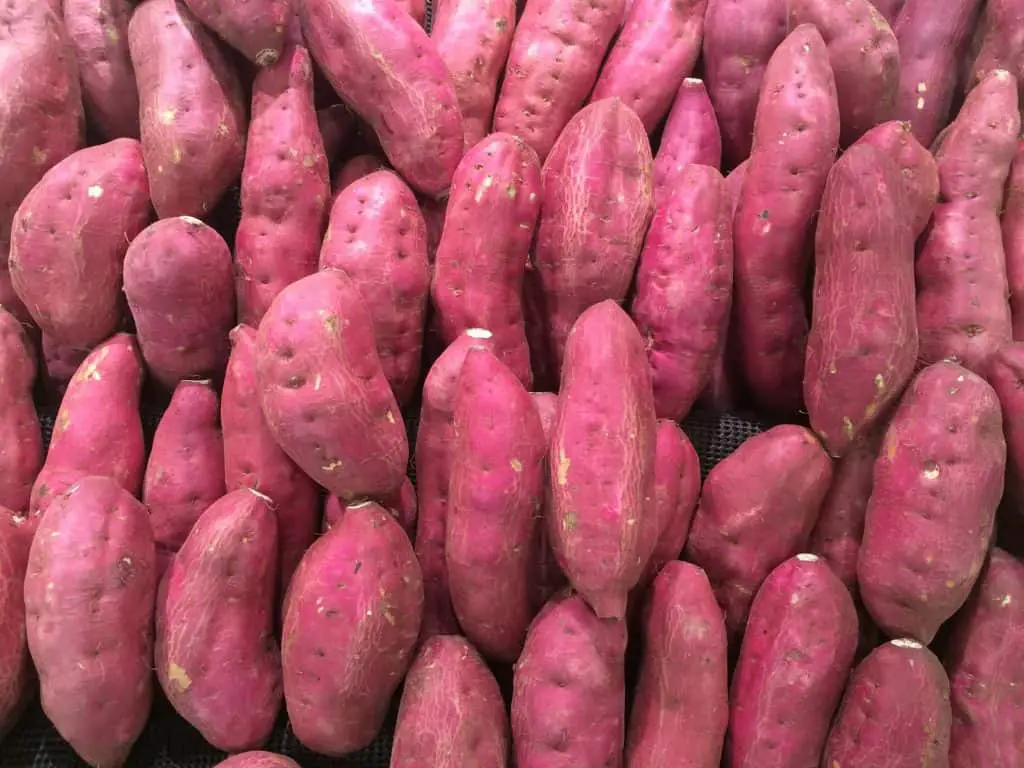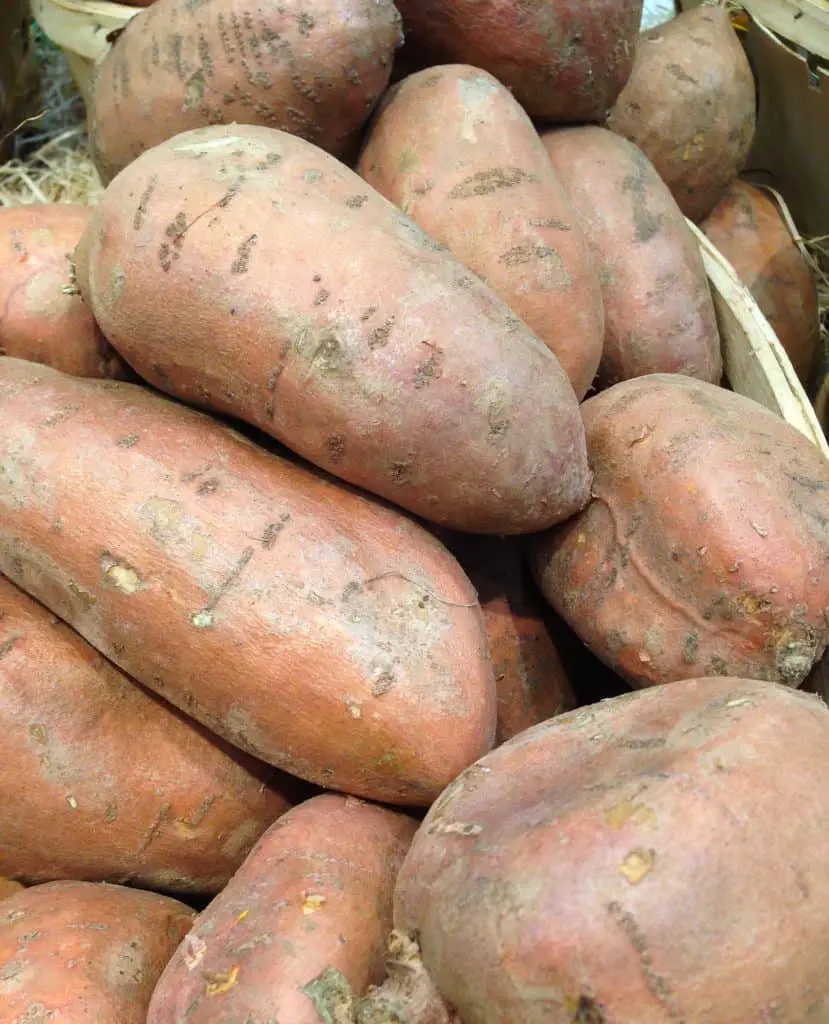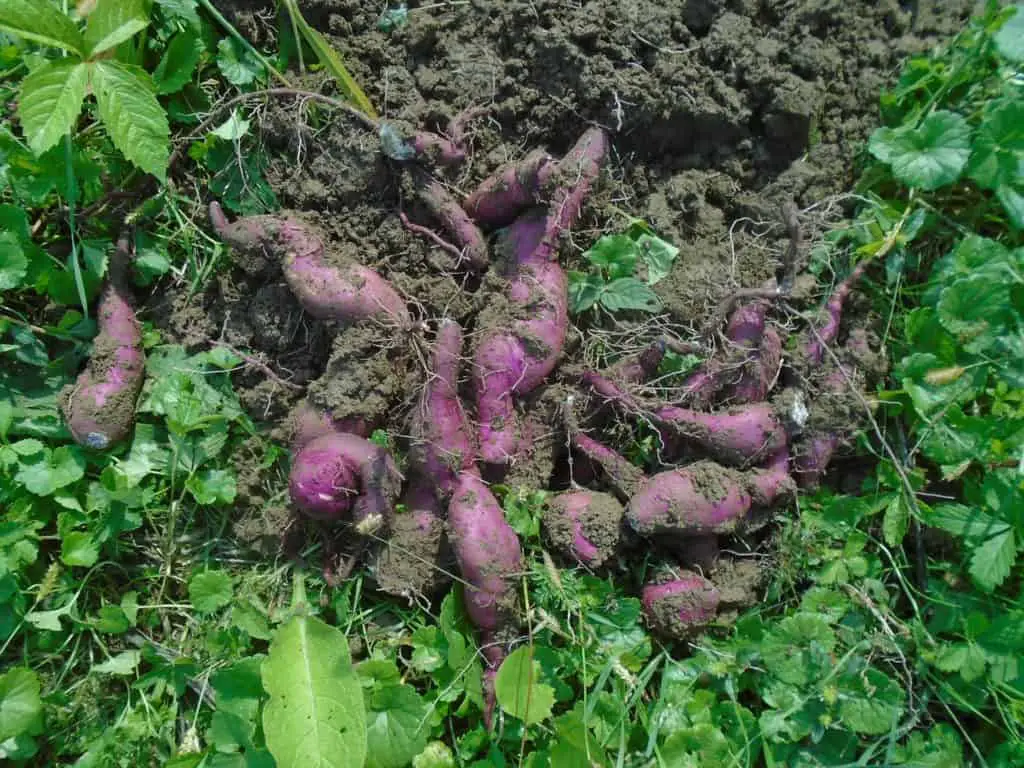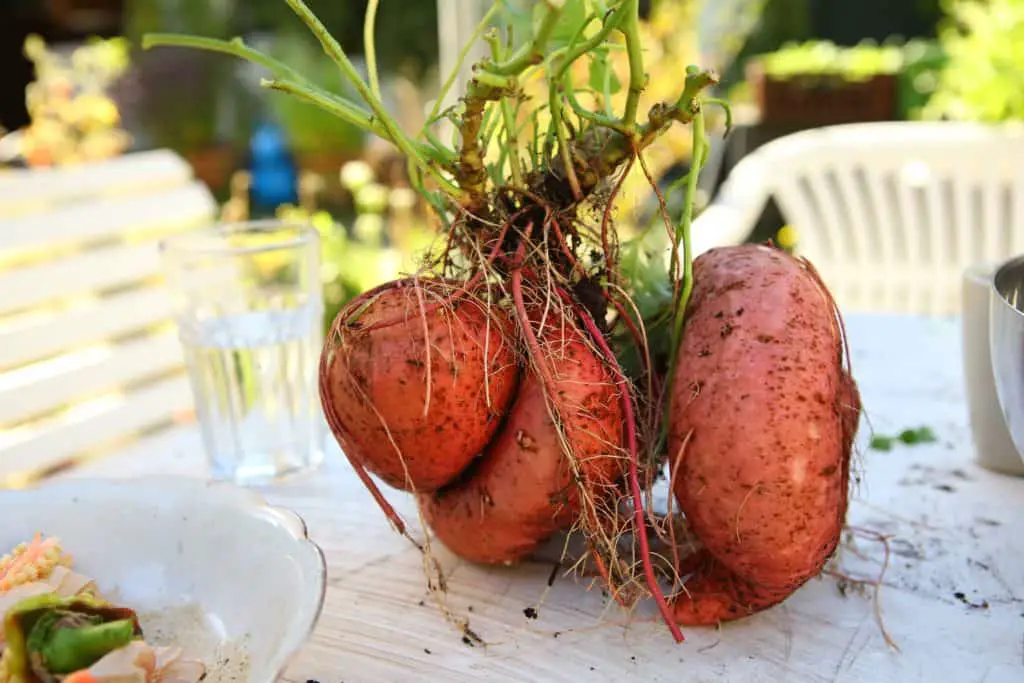With just a little tender loving care, these tubers can flourish even in the poorest conditions.
The plant itself is beautiful in its own right, and the delicious yield is just an added benefit of growing sweet potatoes.
While they do grow best in full sun, they are versatile and you will find that they can thrive in other parts of your garden as well.
Sweet potatoes are classified as a warm-weather crop and can grow world-wide. The most common variant of sweet potatoes are the deep orange and softer ones, commonly known as yams.
How to Grow Sweet Potatoes?
To create the ideal environment for sweet potatoes, create long and wide 10-inch high ridges spaced 3 1/2 feet apart; a 10-foot row will yield 8-10 pounds of potatoes.
Root sprouts, also called slips, can be bought online and from local nurseries; this is what you will want to buy in order to start planting your sweet potatoes.
Sweet potatoes are relatively fast-growing plants, and they generally mature fully within 90 to 170 days; however, it should be noted that they are extremely sensitive to freezing temperatures.
Sweet potatoes do best when they receive 3/4 – 1 inch of rainwater per week.
Like other plants, when sweet potatoes do not receive the adequate amount of moisture, they may be starved and you will end up with stunted growth.
This not only affects the quality of crops that you receive during harvesting but will also affect the yield.
It is best to water during the morning before the sun is beating down on the plants. This not only keeps the leaves from burning but will also work with the sun to allow for evaporation of excess moisture.
To avoid excess moisture that can lead to fungus and bacteria, it is recommended to give the sweet potato plants a good soak once a week; however, this is only if there has not been a decent amount of rainfall.
You should avoid several shallow watering sessions, as the water may not seep down into the soil enough to reach the tubers.
What is the Best Soil for Sweet Potatoes?

I love planting sweet potatoes, as they have the capabilities of growing in very poor soil; however, it should be noted that deformities in the roots can occur if attempting to grow these tubular in heavy clay or sandy dirt.
The soil that you use will come down to personal preference, and what you have had luck with in the past with other vegetables, and planting in general.
Once you have chosen the ideal soil, you will want to make sure to incorporate plenty of compost in the planting; while avoiding fertilizers that are rich in nitrogen, as these will produce lush vines but stunt the growth of tubes.
If you are in the north, or areas that tend to have colder temperatures, you will want to cover the raised rows you have planted with black plastic, as this will absorb some of the heat from the sun and keep the soil warm underneath; promoting growth.
However, if you opt-out of using black plastic, you should mulch the vines two weeks after planting in order to kill weeds, conserve moisture, and keep the soil loose to encourage growth.
In addition to the type of soil that you use, it would also be a good idea to take a look at the area that the sweet potatoes will be growing.
As a reminder, sweet potatoes are a tubular type of plant, which means they need an adequate amount of room in order to grow underground.
Ground that is tough or hard may not be the ideal location; however, tilling the soil can help to ensure that the ground is the right consistency.
Varients of Sweet Potatoes

Not many people would guess it from shopping at their local supermarket, but there are actually 16 varieties of sweet potatoes available for growing and consumption.
In the section below, we will list all of them, as well as their description and flavor.
Speckled Purple Sweet Potatoes
Speckled Purple sweet potatoes as you can guess, are purple in color, remain firm when cooked and have a mild, nutty flavor.
They are fairly versatile and are good choices for baking and roasting.
Heirloom Sweet Potatoes
Heirloom sweet potatoes have pale orange skin and flesh and are a good choice for baking, roasting, and casseroles due to their mild and sweet flavor.
With a sweet and nutty flavor, these are a favorite among holiday dishes.
Hannah
Hannah has tan skin and almost white flesh, however when baked the flesh browns a little to a more yellowish color.
More suited for mashed, these sweet potatoes have a lightly sweet flavor and dry texture Jewel sweet potatoes are one of the more common, and what you are probably accustomed to.
They are the traditional sweet potato of casseroles and have a deep orange skin and flesh.
Garnets
Garnets get their namesake from their red and almost purple skin.
These sweet potatoes are a great choice when baking a pie, as they have a pumpkin-like quality.
Korean Purple Sweet Potatoes
Korean Purple sweet potatoes have a speckled purple skin and white flesh.
When cooked, they have more of a chestnut-like flavor.
Beauregard Sweet Potatoes
Beauregard sweet potatoes are very versatile and are the most widely grown for commercial purposes.
When cooking, they are great when baked, boiled, mashed, or fried.
Creamsicle Sweet Potatoes
Creamsicle sweet potatoes are great for frying or boiling and have a sugary vibrant orange interior O’henry is closely related to the Beauregard, as it was developed as a mutation.
This sweet potato is lightly sweet, and dense when baked Willowleaf is a very rare variant of the sweet potato; with red-orange skin and red flesh.
When baked, it has a nutty flavor.
Okinawas
Okinawas are good in a variety of ways: baked, roasted, boiled, steamed, or scalloped.
They have tan skin and sweet inner flesh Covingtons are rose skinned and have an orange flesh that turns almost malty-sweet when baked.
Nugget Sweet Potatoes
Nugget sweet potatoes are great for roasting and glazing, with rosy skin and light orange dense flesh
Amish bush Porto Rico
Amish Bush Porto Rico have rosy skin with orange flesh that when baked, turns out to be butter.
Lushious Purple Sweet Potatoes
lushious Purple sweet potatoes are one of the more tart varieties and are best suited for generously seasoned savory dishes.
Stokes Purple Sweet Potatoes
Stokes Purple Sweet Potatoes are different from the other varieties in the sense that they are the same color on the outside as they are all the way through.
Due to their low moisture content, they are best cooked slowly at low temperatures.
How to Plant Sweet Potatoes

When it comes to the time of year that is ideal for planting, it should be done in full sun four weeks after the last frost of the season.
Planning ahead around six to eight weeks before it is time to start growing your garden, you will want to start prepping for the growth of sweet potatoes ahead around six to eight weeks before it is time to start growing your garden, you will want to start prepping for the growth of sweet potatoes.
To prepare for planting, acquire a box of moist sand, sawdust, or chopped leaves and have a warm location in mind.
Once you have these, you will want to place the slips in this box.
Soon, shoots will sprout, and when measured they are 6 to 9 inches long. go ahead and snip them off from the root.
It is important to note that the bottom inch of each slip sometimes contains disease organisms, and should just be removed and disposed of.
Because of the nature of tubers in general, it would be wise to till the soil that the sweet potatoes will be growing in.
They can grow up to 2 feet underground, and allowing adequate room will not only encourage growth but will net you a higher yield at the end of the season when they are ready to be harvested.
Can They be Grown in Containers?
Although sweet potatoes can be grown in containers, it should be noted that this will most likely move the plant from being a perennial to an annual.
Similar to growing sweet potatoes in the ground, when grown in a pot or planter they prefer to have warm days and nights.
When selecting your slip for growing sweet potatoes this way, you will want to choose bush varieties to avoid the overgrowth that can come with sweet potato plants.
When purchasing, it would be wise to avoid the slips that are sold in grocery stores, as there is no way of knowing what type of sweet potato it is for sure.
When growing sweet potatoes this way, you will want to make sure that there is adequate room for them to grow beneath the plant.
Most sweet potatoes, like other tubers, will grow up to 2 feet under the top of the soil, so making sure your pot or container is deep enough is key to having a good yield.
As with growing sweet potatoes in the ground, you will want to make sure that the quality of soil is good for them to obtain the amount of nutrients and vitamins that they need.
You will also want to check periodically to ensure that there is not a presence of pests that can harm the sweet potato plant.
What Containers are Best Suited to Grow Sweet Potatoes?
As stated above, when choosing a pot or container for growing sweet potatoes you will want to choose one that is deep enough to house the tubers.
Additionally, you will want to avoid plastic or metal containers; however, clay, ceramic, and whiskey barrels made of wood are all good choices.
Whatever planting container that is chosen, ensure that there is proper drainage.
Sweet potato plants that are grown this way favor more of a sandy soil, which has compost mixed in.
You will want to plant your slips no less than 12 inches apart and make sure the plants are kept indoors for 12 weeks to enable establishment before moving it outside.
Because of the nature of potted plants, you will want to avoid over-watering; once a week is sufficient.
Can They Be Grown Indoors?
The answer to this question is: yes and no.
Although if growing your sweet potato in a pot, it is recommended to grow indoors for 12 weeks prior to bringing the pot outdoors for the remainder of the season.
It is possible however to grow sweet potatoes indoors under the right conditions. Sweet potatoes need plenty of sun, and a warm environment to grow in.
If you have an area that they can have both of these, there should be no reason that they cannot be grown indoors.
For instance, a full sunroom with a heat lamp aimed directly on the sweet potato plants should provide adequate sunlight and warmth for them to grow.
However, they may not thrive as much as they would in an outdoor environment.
How to Fertilize Sweet Potatoes
While choosing the fertilizer for your sweet potatoes, you will want to decide on one that is higher in potassium and phosphate than nitrogen.
The reason for this is because nitrogen would encourage the growth of more foliage, but we are looking at the growth of the tubers themselves. By looking at the numbers that are located on the back of the fertilizer, you will see the levels of these three components.
For instance, in a bottle of fertilizer that has the numbers 10-10-10, there are equal levels of 10% of potassium, nitrogen, and phosphate.
The type of fertilizer that you choose to use will have a direct impact on the sweet potato plants, as well.
For instance, using granular fertilizer is fine while the plants are still relatively small; however, it can burn the plants if it comes into direct contact with them.
For this reason, it is recommended to use a water-soluble fertilizer; as the plants start to mature, it is easier to use a fertilizer that you can mix in water.
Additionally, you can use this water-soluble fertilizer in your normal plant care routine, saving you time.
After waiting for 2 weeks after planting, you can now start to fertilize the sweet potato plants.
During the season, you can continue to fertilize the plants every 4-6 weeks, ceasing watering 3 weeks before the harvesting season.
In most cases, 3 rounds of fertilization is sufficient for sweet potatoes.
How to Harvest Sweet Potatoes

Sweet potatoes can are ready to be harvested once you notice the leaves start to turn yellow, however, the longer that you wait to harvest, the more nutrients are absorbed from the soil; as well as a higher yield that will be received.
It is wise to make sure to harvest sweet potatoes before frost sets in, as this can blacken the vines; which leads to rot relatively quickly.
Carefully using a spading fork on a sunny day with dry soil, you can dig up the sweet potatoes; just be careful and remember that they can grow up to a foot or more from the plant.
After you dig up the tubers, you will want to cure them by drying in the sun for several hours and then storing them in a well-ventilated area for 10 to 15 days.
Once cured, you will want to store them at around 55 degrees; cured sweet potatoes will stay fresh for several months.

Pests to Look Out For, and How to Eliminate Them!
Due to the nature of insects, gardeners in southern regions will have to deal with pests much more often than those of the north.
The most common pests that you have to watch out for when growing sweet potatoes are Sweet Potato Weevils, fungal diseases such as Black Rot, and Wilt (stem rot).
More information on both, and how do deal with each below.
It is important to keep in mind that sweet potatoes are a vining plant, and as such too much moisture can make their environment a breeding ground for fungal and bacterial infections.
Sweet Potatoe Weevils
The 1/4-inch bodies of these pests are red-orange, with dark blue heads and wings.
They puncture stems and tubers in order to lay their eggs; which is how they reproduce. Larvae travel to and feed on the roots, while matured weevils tend to prey on the vines and leaves; if you spot any leaves that have holes in, it could be a sign of the appearance of weevils.
In addition to just plain being gross, weevils also have the potential to spread food rot.
Although in small numbers, they may not seem that harmful, what makes them so dangerous is the rate at which they can reproduce.
Although it is difficult to eliminate weevils, the best course of action is to isolate the problem; whenever you see the occurrence of them, make sure to discard the contaminated food.
In the case of sweet potatoes, whole plants can be compromised, and it is necessary to dispose of the root as well as the plant.
Using disease-resistant slips and implementing a four-year crop rotation can prevent the occurrence of weevils on your crops.
Black Rot
This one is fairly easy to detect, as it appears as dark circular depressions on tubers.
Once infected, the plant is not salvageable and the best practice is to discard the infected potatoes, as to avoid the fungal infection spreading to healthy ones.
Stem Rot (wilt)
This is a fungus that preys on plants that have already been injured by insects, poor cultivation, or wind.
Although this disease may not completely kill the plants, the yield that you receive will be very poor due to it.
In order to avoid fungal infections, plant only healthy sips; additionally, you can plant resistant cultivars and by keeping fleshy roots at 55 to 60 degrees.
